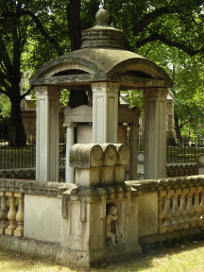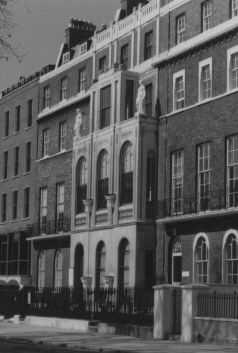

A global archive of independent reviews of everything happening from the beginning of the millennium
For publication dates click here
Read our Copyright Notice click here

Sir John Soane's tomb in St Pancras Gardens, said to be the inspiration for the old Post Office telephone box
March 2019
Soaneian detail at the Bank of
England
The article was first published in Building Design. 18 months after I follwed up with a piece on the Bank of England Museum which has some of the Soane heritage.
Architects have often cited Soane as a bridge between classicism and modernism. I went to the Bank in search of the evidence but perhaps too little of his work at his erstwhile masterpiece remains to have conclusively provided it.
He was a bridge but I prefer to think of him as a one off. He was also a very persistent architect in pursuit of what he wanted.
Persistence is a quality.
When I arrived in 1989 by appointment at the Bank I met, briefly, someone I found unusual, likeable and interesting: Theresa May.
*****
Five years on or so, this time at Gray's Inn, I met, briefly, someone I found unusual, likeable and interesting: and also destined to be Prime Minister.
THE SIR JOHN SOANE'S MUSEUM, LINCOLN'S INN FIELDS, LONDON
Reviewed by ANDRE BEAUMONT
During Sir John Summerson's 39 years as Curator, ending in 1984, the reputation of the museum rose progressively, gaining through association with his superlative architectural criticism and from his gentlemanly encouragement of scholars and students.
This coincided with a period where there was a genuine increase in interest in Soane.
Summerson, however, concentrated largely on scholarship and left the disposition of the Museum much as he had found it.
Soane had built formidable defences for his Museum, almost equal to those of a pharoah - the Museum had been established by decree of Parliament and the disposition of the collection was not to be altered. His personal Museum, in effect his house now with the house next door, was to be maintained in a continuum of time.
When Peter Thornton succeeded Summerson he did not see why this could not mean that the Museum could be improved and made more accessible to non-scholars.
This review is of the Museum and of what he viewed as his aims for it on succeeding to the Curatorship.
He had visibly achieved much before as Keeper at Osterley, one of the great Robert Adam houses, where much restoration had taken place (all of which he stressed could be reversed if it were subsequently found to be misjudged).
Trained as an engineer, he had been head of the furniture department at the Victoria and Albert Museum and Keeper of both Osterley and Ham House before coming to the Soane Museum.
Part of the appeal of the Soane Museum is that it is essentially a domestic house. Its domesticity is intrinsic, too, to its character as a museum and its role as an architectural masterpiece. It is alive, too, and requires people to interact with it. One senses that the first changes Peter Thornton made at the Museum all reinforced its domestic quality.
A few months after assuming the Curatorship, Peter Thornton expressed great interest in restoring the breakfast room and dining room in No. 12 the Soanes' first house in Lincoln's Inn Fields next door to the main museum building at No. 13 with its famous Breakfast Parlour - to demonstrate more of the domestic nature of the house Soane lived in.
 The Soane Museum
The Soane MuseumThese rooms were not normally accessible to the visitor but the breakfast room has an airy trellis-pattern ceiling in poor condition reminiscent of another at Soane's country house, Pitzhanger Manor, Ealing. Restoration of these rooms in order to open them to visitors had to await solving the problem of access to them but improvements to the fabric of No. 13 went ahead. The inhabited caretaker's rooms above the Curator's office were refurbished and sealed against leaks, stair treads replaced where over-worn, the Piranesi drawings moved to behind shutters in the Picture Room to protect them from sunlight and the table moved from the Library to allow Soane's intended reflection of vistas in the low-level mirrors.
Peter Thornton's appointment to the Soane Museum coincided with an increase in the government' s funding of the Museum from an insubstantial £160,000 per annum, from which everything including salaries had to be paid, to a somewhat more generous £250,000 per annum at the time, which allowed a little leeway for essential work to the structure. Nevertheless, a single item, like the repair of the Axminster carpet in the Library, was estimated then to cost £17,000, so the pace of improvements was of necessity measured.
More significantly, the Upper Drawing Office, a predominantly top-lit room, where Soane or his assistants would do their architectural drawings with spectacular vistas of the house before them, and which Peter Thornton called the "nicest room in the house", was cleared of numerous items, to restore the vistas and the feel of a drawing office.
At the same time, a New Model Room was created in what had been Soane's bedroom on the second floor. This was made to accommodate the architectural models displaced from the Upper Drawing Office and elsewhere in the house to a place where they might be better viewed. It was also planned that the Monument Court be repainted and a monument reinstated.
In planning all these changes the Curator sounded out his visitors and staff for views and those undertaken all represented changes of sound judgment that left the architectural devices, the collection and the ensemble more readily understood.
This in a museum where the arrangement of the collection must remain as Soane left it when he died or, possibly, as he consciously disposed objects during his lifetime.
Another function of the Museum is clearly as a resource for scholarship. Only 300 people a year at the time used the Adam Drawings Collection of 8000 drawings. In purchasing the drawings in 1833 Soane acquired the work of an architect he must have considered an earlier kindred spirit, an innovator working within but extending the borders of the classical idiom.
The Adam drawings are always so striking in the manner in which they represent so closely in two-dimensional form the three-dimensional reality of the Adam brothers' buildings. There is none of the intermediation of drawing conventions between drawings and reality found in modern architectural drawings. The rapport is, also, more direct than that found in contemporaries' drawings. Naturally, this rapport was helped by Robert Adam's increasingly two-dimensional style in his later years but it is equally found in his drawings of non-linear spaces, such as sections through circular staircases.
Of all Soane's acquisitions for his Museum, that of the Adam drawings was the most enlightened. It signaled his acceptance into a museum, where all the objects were in a perspective fashioned by himself and all angled towards posterity, of objects of a collective stature that could stand quite independently of any frame of his own making. In purchasing them, he provided a second purpose for the existence of his museum.
Peter Thornton admitted to enjoying the Curatorship immensely. With his evident enthusiasm it was unlikely that the post could lie fallow. For the first nine months, he worked at the Museum full-time but as the post was a part-time one he took up the offer of a one-year research fellowship at St. John's College, Oxford, which he described as being 'without strings' such as teaching duties. This he evidently enjoyed while at the same time preparing a book on the interior decoration aspects of the Italian Renaissance.
The Soane Museum progressed towards being a more clearly understood ensemble, whilst remaining a reference point in Soane's long perspectives of time.